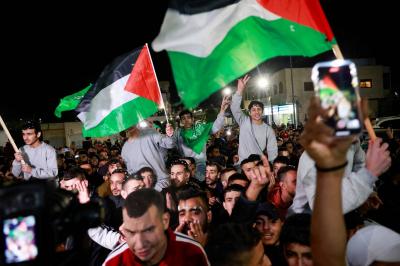Thirteen Israelis and four Thais released by the Palestinian militant group Hamas arrived in Israel today, Sunday, as part of the second phase of a significant exchange agreement that briefly faced collapse due to a dispute over aid delivery to Gaza. The short-term disagreement, which threatened the temporary ceasefire for releasing hostages mediated by Qatar and Egypt, was resolved, highlighting the fragility of the agreement, under which 50 Israeli hostages are exchanged for 150 Palestinian prisoners over four days.
Television footage showed hostages on the Egyptian side of the Rafah border crossing after leaving Gaza, where Hamas handed over the detainees to the International Committee of the Red Cross late Saturday evening. Among the thirteen released Israelis were six women and seven children and minors. The Israeli army stated, "The released hostages are on their way to hospitals in Israel, where they will be reunited with their families."
The Palestinian news agency reported that among the Palestinian prisoners released from Israeli jails were six women and 33 minors. A Reuters witness noted that some of the released individuals arrived at the mayor's square in Al-Bireh in the Israeli-occupied West Bank, where thousands of citizens were waiting for them. A Palestinian official familiar with the related diplomatic efforts stated that Hamas would continue to implement the agreed-upon ceasefire with Israel for four days.
This exchange on Saturday followed the release of another 13 Israeli hostages, including children and elderly women, from Hamas custody in exchange for the release of 39 Palestinian women and minors from Israeli prisons. Additionally, on Friday, Hamas freed ten Thai and Filipino farm workers.
**How to Determine Release Priority**
The agreement faced the risk of derailing earlier on Saturday after the military wing of Hamas announced it would postpone the scheduled second round of hostage releases until Israel met all ceasefire conditions, including a commitment to allow aid trucks into northern Gaza. Osama Hamdan, a Hamas spokesman, stated that a total of 340 aid trucks had entered Gaza since Friday, with 65 reaching northern Gaza, which is less than half of what Israel had agreed to.
The Israeli army stated that the distribution of aid within the Gaza Strip is conducted by the United Nations and international organizations. The UN reported that 61 aid trucks were delivered to northern Gaza on Saturday, the highest number since October 7. These trucks include food, water, and emergency medical supplies. The Ezzedin Al-Qassam Brigades, Hamas's armed wing, claimed that Israel had not fulfilled the conditions for releasing Palestinian prisoners, as the detainees were not released according to their seniority as expected.
Qatari Foreign Ministry spokesperson Majid Al-Ansari stated on Saturday that there was "a lot of discussion" about how to determine the priority for releases. For the Palestinian side, the main criterion was the length of time the person had spent in Israeli prisons. He told CNN, "We hope that now, with the second or third day of this ceasefire, we will be able to discuss many of these details that made this day extremely difficult."
Ensuring that the agreement did not collapse took a day of high-level diplomacy mediated by Qatar and Egypt, a process in which U.S. President Joe Biden also participated by calling Qatari Emir Sheikh Tamim bin Hamad Al Thani. Israel stated that the ceasefire could be extended if Hamas continued to release hostages at the rate of at least ten hostages per day. A Palestinian source indicated that up to 100 hostages might be released.




